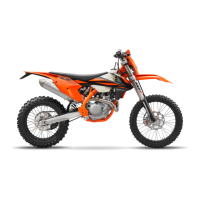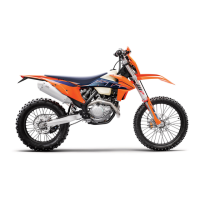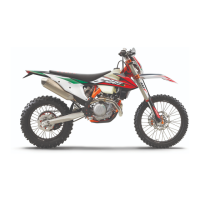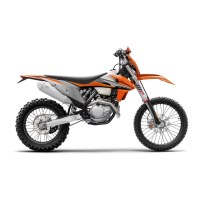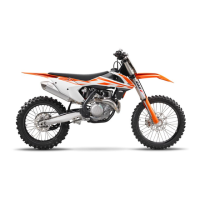
Do you have a question about the KTM 450 EXC-F 2017 and is the answer not in the manual?
| Engine Type | Single Cylinder, 4-Stroke |
|---|---|
| Displacement | 449.3 cc |
| Bore x Stroke | 95 x 63.4 mm |
| Compression Ratio | 12.75:1 |
| Ignition | Keihin EMS |
| Starter | Electric Starter |
| Transmission | 6-speed |
| Final Drive | Chain |
| Front Brake | Disc brake, 260 mm |
| Rear Brake | Disc brake, 220 mm |
| Front Tire | 90/90-21 |
| Rear Tire | 140/80-18 |
| Seat Height | 960 mm |
| Ground Clearance | 355 mm |
| Fuel System | Electronic fuel injection |
| Front Suspension | WP USD Xplor 48 |
| Rear Suspension | WP XACT |
| Frame | Chromoly Steel |
Explains the meaning of specific symbols used throughout the manual.
Details the typographical formats used for names and terms in the document.
Defines the intended operational use of the KTM sport motorcycles.
Provides essential safety advice and mentions warning labels on the vehicle.
Explains danger, warning, caution, and note symbols and their associated risks.
Warns against tampering with noise control systems and lists prohibited acts.
Covers safe riding, avoiding hazards like alcohol, and component temperatures.
Emphasizes the importance of wearing appropriate and well-maintained protective gear.
Outlines rules for performing work and environmental considerations for motorcycle use and disposal.
Stresses the importance of reading the manual and keeping it accessible for reference.
Details warranty conditions, voiding causes, and service records.
Advises on using specified substances and environmental hazards of improper handling.
Recommends using KTM-approved parts and installation by authorized workshops.
Highlights the importance of proper service for performance, wear prevention, and longevity.
Notes that figures may show special equipment and components might be shown disassembled.
Directs users to authorized KTM dealers for questions and provides website information.
Identifies key components like levers, filler cap, and stands in a front-left view.
Identifies controls, numbers, and parts in a rear-right view of the vehicle.
Shows the location and method of identifying the chassis number on the motorcycle.
Indicates the location of the type label, typically on the steering head.
Explains where the key number for the steering lock is stamped.
Shows how to find the engine number embossed on the engine casing.
Specifies the location of the part number stamped on the inner side of the fork stub.
Details the location where the shock absorber article number is stamped.
Describes the clutch lever's location, hydraulic operation, and self-adjustment.
Identifies the hand brake lever and its use for activating the front brake.
Locates the throttle grip on the right handlebar and its function.
Explains the kill switch's location and its two states for ignition control.
Details the horn button's location and how to activate the horn.
Describes the light switch positions for low beam and high beam operation.
Explains the turn signal switch positions for activating left and right signals.
Identifies the emergency OFF switch and its states for ignition control.
Locates the electric starter button and describes its basic position and pressed state.
Explains the mapping selection and activation of Launch/Traction Control via the switch.
Details the meaning of various indicator lamps like high beam, malfunction, and fuel level.
Provides instructions on how to open and close the fuel filler cap safely.
Explains the function and operation of the cold start button for cold engines.
Describes the idle speed adjusting screw and how to increase or decrease idle speed.
Shows the location of the shift lever and illustrates gear positions.
Identifies the foot brake lever and its use for activating the rear brake.
Explains the side stand's function for parking and securing it during rides.
Details the steering lock's function and the procedure for locking and unlocking the steering.
Introduces the speedometer display and the buttons used for function control.
Explains how the speedometer activates and performs a display test for functionality.
Guides on changing the unit of measurement from kilometers to miles and vice versa.
Details how to activate or deactivate various speedometer functions and modes.
Provides step-by-step instructions for setting the current time on the speedometer.
Explains how to access and view recorded lap times, including deletion.
Describes how to select and view the current speed in km/h or mph.
Explains how to view the engine's service hours displayed in this mode.
Details how to access and navigate the speedometer's setup menu for various settings.
Explains how to change the unit of measurement for speed (km/h or mph).
Describes how to display the current time on the speedometer.
Provides detailed steps for adjusting the clock display on the speedometer.
Explains how to use the stopwatch function to time laps.
Describes how to view recorded lap times from the stopwatch.
Explains how to view the total accumulated distance traveled.
Details the trip master function for measuring distances and its relation to average speed.
Explains the second trip master function, useful for navigation or logging.
Guides on manually setting the trip master 2 value, useful for road books.
Describes how to view the average speed calculated from trip master 1.
Explains how to view the average speed calculated from stop watch 2.
Details how to use the first stop watch function linked to trip master 1.
Explains how to use the second, manual stop watch function.
Covers crucial advice for new riders, including safety, controls, and basic handling.
Outlines the recommended procedure for running in the engine to ensure longevity.
Explains how low temperatures affect lithium-ion battery starting power and warming procedures.
Provides guidance on adapting the vehicle for various challenging riding environments.
Details specific preparations for riding the motorcycle on dry sandy terrain.
Outlines necessary steps for riding on wet sandy conditions.
Advises on preparing the vehicle for riding on wet and muddy terrain.
Offers tips for riding in high temperatures and at slow speeds.
Provides guidance for operating the motorcycle in cold conditions or snow.
Lists essential checks and maintenance tasks to perform before every trip for safety.
Details the correct procedure for starting the motorcycle's engine safely.
Explains how to activate Launch Control for optimal race starts, with warnings.
Describes how to activate Traction Control to reduce rear-wheel slip for better control.
Guides on smoothly engaging the clutch and opening the throttle when starting from a standstill.
Covers proper gear shifting techniques, throttle control, and clutch usage.
Provides instructions on effective braking, avoiding wheel lock-up, and maintaining brake efficiency.
Details safe methods for stopping the motorcycle and parking it securely.
Offers advice on securing the motorcycle for transportation to prevent damage or accidents.
Covers safety precautions and the correct procedure for refueling the motorcycle.
Mentions that additional work may need separate ordering and invoicing.
Lists essential maintenance tasks required at specific intervals (e.g., every 30 operating hours).
Outlines recommended service tasks based on operating hours and usage (motorsports).
Explains how to adjust basic suspension settings based on rider weight for optimal handling.
Details the two ranges (high-speed, low-speed) of compression damping for the shock absorber.
Guides on adjusting the low-speed compression damping of the rear shock absorber.
Instructs on how to adjust the high-speed compression damping of the shock absorber.
Explains the process for adjusting the rebound damping of the rear shock absorber.
Describes the procedure for measuring the rear wheel dimension without load using a sag gauge.
Details how to check the static sag of the shock absorber to ensure proper setup.
Explains the method for checking the riding sag with the rider on the motorcycle.
Provides instructions on how to adjust the spring preload of the shock absorber.
Guides on adjusting the riding sag, potentially involving spring replacement or preload changes.
Discusses factors affecting fork setup, including bottoming out and need for bleeding.
Explains how to adjust the compression damping for the front fork legs.
Details the procedure for adjusting the rebound damping of the front fork.
Instructs on adjusting the spring preload specifically for the EXC-F Six Days fork.
Explains how handlebar holders can be mounted in different positions for ergonomic adjustment.
Provides instructions on how to adjust the handlebar position and warns against using bent handlebars.
Details the safe procedure for lifting the motorcycle using a lift stand.
Explains how to safely remove the motorcycle from the lift stand.
Guides on releasing excess pressure from the fork legs by opening bleeder screws.
Describes how to clean the dust boots to prevent dirt accumulation and oil seal damage.
Outlines the steps for safely removing the front fork legs from the motorcycle.
Provides instructions for correctly installing the front fork legs, including torque specifications.
Details the process for removing the fork protectors from the front forks.
Guides on how to reinstall the fork protectors with correct screw tightening.
Explains the steps to remove the lower triple clamp for EU/AU models.
Details the procedure for removing the lower triple clamp for Six Days models.
Guides on installing the lower triple clamp for EU/AU models, including lubrication.
Provides instructions for installing the lower triple clamp on Six Days models.
Explains how to check for play in the steering head bearing and potential damage.
Guides on adjusting steering head bearing play for EU/AU models.
Details adjusting steering head bearing play for Six Days models.
Describes the process of lubricating the steering head bearing.
Outlines the steps for removing the front fender.
Guides on how to properly install the front fender.
Provides instructions for safely removing the rear shock absorber.
Details the correct procedure for installing the shock absorber, including torque specs.
Explains how to remove the motorcycle seat.
Guides on correctly installing and securing the motorcycle seat.
Describes how to remove the air filter box cover.
Guides on reinstalling the air filter box cover.
Explains how to remove the air filter from its housing.
Details the procedure for installing a clean air filter, emphasizing correct seating.
Provides instructions for cleaning the air filter and its box, including drying and oiling.
Describes how to seal the air filter box in a marked area.
Explains how to secure the air filter box cover, possibly involving drilling a hole.
Details the steps for removing the main exhaust silencer.
Guides on correctly installing the main exhaust silencer.
Explains how to change the glass fiber yarn filling inside the main silencer.
Provides instructions for safely removing the fuel tank.
Guides on correctly reinstalling the fuel tank, ensuring proper routing of lines.
Describes how to check the motorcycle chain for dirt accumulation.
Outlines the procedure for cleaning the motorcycle chain and applying chain spray.
Explains how to check the chain tension and the consequences of incorrect tension.
Guides on how to adjust the chain tension correctly, ensuring proper alignment.
Details how to check the chain, sprockets, and chain guide for wear and proper seating.
Describes how to inspect the frame for damage, cracking, or deformation.
Guides on inspecting the swingarm for damage, cracking, or deformation.
Explains how to check and correct the routing of the throttle cables.
Advises on checking the rubber grips for damage, wear, or looseness.
Guides on adjusting the clutch lever's position for rider comfort.
Details how to check and maintain the correct fluid level in the hydraulic clutch system.
Provides instructions for changing the hydraulic clutch fluid, including bleeding the system.
Explains how to remove the engine guard for specific models.
Guides on reinstalling the engine guard for specific models.
Explains how to check the free travel of the hand brake lever and its importance.
Guides on adjusting the free travel of the hand brake lever for proper operation.
Details how to check brake disc thickness for wear and inspect for damage.
Explains how to check the brake fluid level in the front brake reservoir.
Guides on how to add front brake fluid safely, emphasizing correct type and level.
Details how to check the minimum thickness and condition of the front brake linings.
Provides instructions for changing the front brake linings, including safety warnings.
Explains how to check the free travel of the foot brake lever for the rear brake.
Guides on adjusting the foot brake lever's position for optimal control.
Details how to check the brake fluid level in the rear brake reservoir.
Guides on how to add rear brake fluid safely, emphasizing correct type and level.
Explains how to check the minimum thickness and condition of the rear brake linings.
Provides instructions for changing the rear brake linings, including safety warnings.
Outlines the procedure for safely removing the front wheel.
Guides on correctly installing the front wheel, including spacer placement and tightening.
Details the steps for safely removing the rear wheel.
Provides instructions for correctly installing the rear wheel, including chain and tensioner adjustment.
Explains how to check tires for cuts, wear, tread depth, and age.
Details the correct procedure for checking tire air pressure for off-road and road use.
Guides on checking spoke tension for wheel integrity and handling characteristics.
Explains the procedure for safely disconnecting and removing the motorcycle battery.
Guides on correctly installing the battery, ensuring correct terminal connections.
Details the process for recharging the battery, including voltage checks and charging parameters.
Provides instructions for locating and replacing the main fuse to protect the electrical system.
Explains how to locate and replace fuses for various vehicle components under the seat.
Outlines the steps for removing the headlight mask assembly.
Guides on reinstalling the headlight mask assembly and securing it.
Details the procedure for replacing the headlight bulb and parking light bulb.
Explains how to replace the turn signal bulb.
Describes how to check and verify the correct headlight beam alignment.
Guides on how to adjust the headlight's vertical range for proper illumination.
Details the process for replacing the battery in the speedometer unit.
Indicates the location of the diagnostics connector, typically found under the seat.
Explains the basic function of the water pump, radiator cap, and cooling effect.
Provides instructions for checking the coolant level and antifreeze protection.
Details the procedure for checking the coolant level specifically in the radiator.
Guides on how to safely drain the coolant from the cooling system.
Explains the process for refilling the cooling system with the correct coolant mixture.
Describes how to check for correct play in the throttle cable for smooth operation.
Guides on adjusting the throttle cable play to ensure proper throttle response.
Explains how to change the engine's throttle response characteristic by swapping guide plates.
Details how to select different engine mapping modes using the combination switch.
Provides instructions for setting the engine's idle speed to the specified RPM range.
Explains the procedure for teaching the throttle valve position to the control unit.
Guides on checking the shift lever's position relative to the rider's boot for proper engagement.
Details how to adjust the shift lever's position for optimal ergonomics and function.
Provides instructions for replacing the fuel screen to ensure clean fuel delivery.
Explains how to check the engine oil level at operating temperature.
Details the process for changing the engine oil and oil filter, including cleaning oil screens.
Guides on how to add engine oil, emphasizing using the correct type and quantity.
Provides detailed instructions for cleaning the motorcycle, including warnings about pressure washers.
Outlines necessary steps for protecting the motorcycle when operating in winter conditions with road salt.
Details the steps for preparing and storing the motorcycle for extended periods.
Explains the procedure for getting the motorcycle ready for use after it has been stored.
Lists detailed technical specifications for the motorcycle's engine.
Provides torque specifications for various engine components during assembly or maintenance.
Lists the required capacities for engine oil, coolant, and fuel.
Specifies the total fuel tank capacity and the approximate fuel reserve.
Details technical data related to the motorcycle's chassis, frame, and suspension.
Lists technical data for electrical components like battery, fuses, and lights.
Provides information on tire sizes, types, and validity for different models.
Details technical data for the front fork, including damping, spring rates, and oil.
Lists technical data for the rear shock absorber, including damping, spring rates, and preload.
Provides essential torque specifications for various chassis components.
Defines the term OBD (On-board diagnosis) and its function.
Explains the meaning of yellow and orange symbols indicating errors or warnings.
Explains the meaning of green and blue symbols that provide information.

